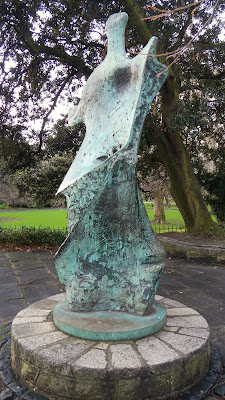
Another of my favorites, also by Oisin Kelly, is this depiction of Jim Larkin. It is sited on a high plinth in the middle of OConnell Street and the figures upward sweeping arms, oversized hands and rough texture all say one thing to the viewer; rise up. A powerful piece.
|
|
This sculpture of four trumpeters is quite unusual in its arrangement being centered within a fountain surrounded by alternate panels of glass and bronze relief. I am not sure but I think the sculptor may be Edward Delaney.
The Famine Memorial on Custom House Quay by Rowan Gillespie is a powerful and haunting arrangement of figures. Its success is due to the wonderful modeling, the bravery of the artist in depicting the horror of starvation and the highly textured surface. The surface includes "flashing" which is small traces of bronze which seep into fine cracks in the moulds surface when casting. These are usually removed but have been retained by the artist to great effect.
This piece by Henry Moore is not often seen in its rather secluded location within Saint Stephen's Green. Maybe not one of his best but I love the texture carved into the original paster artwork before it was cast into bronze. Looking at Moores work always reminds me of the interesting time I had working at the Henry Moore Institute in Leeds 10 years ago.
This massive, complex and skillfully made monument to Daniel OConnell is impossible to miss in Dublin city but as with much Victorian sculpture is quite stayed and does not have the energy of some of the other pieces I have mentioned. There are a few bullet holes in the sculpture which occurred during the 1916 uprising.
When walking into the main entrance of Trinity College you will see this sculpture of Oliver Goldsmith on the right hand side. It is one of two figures set either side of the entrance made by John Henry Foley who is also the sculptor of the OConnell monument but this piece is more successful through its weight distribution, composition and charm. A conventional piece for sure but it works well.
Lastly another piece by Oisin Kelly. The Children of Lir in the Garden of Remembrance is slightly outside the city centre and again is not seen by many but is well worth a look. This piece was enlarged and cast in Italy from Kelly's original model but I can forgive him this as it is a massive piece and maybe the facilities were not available in Ireland at the time.
So thats it, please let me know any of your own thoughts in the comment section and maybe seek out the sculptures if you go to Dublin. There are many more sculptures in the city to see, some figurative some not but as I mentioned these are a few of my favorites.
|
Thursday, 3 January 2013
Figurative Sculptures in Dublin
Subscribe to:
Comments (Atom)










